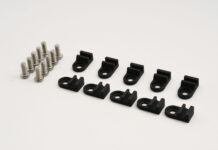TREMEC’s Updated TKX Overdrive Transmission
By Jeff Smith
The automotive performance industry is all about improvements. It’s about adding performance or to enhance the driving experience. If the engineers are exceptionally talented, the product does both. TREMEC lit a fire under the five-speed market with the original T-5 that was eventually used in multiple Chevrolet and GM applications in the ’80s, but it wasn’t really designed to handle the torque of a healthy small-block Chevy. This pushed the development of the TKO five-speed that was eventually upgraded to withstand 600 lb-ft of torque.
This five-speed has been a staple overdrive trans choice for many years, but with this following also came the demand for improvements. The biggest issues revolved around its ability to both shift at engine speeds beyond 6,000 rpm and changes that would make it easier to retrofit across several different body styles. Clearly TREMEC has been listening because just recently the company released the TKX as the latest evolution of the venerable five-speed.

The first main point of improvement is that the trans case has been completely redesigned to both reduce its overall height and width while also improving strength. This will allow the new TKX to fit into the entire year span of early Chevelles from 1964-1972. For years, trans swappers have been well aware that early A-bodies require substantial floorpan modifications and often all-new trans tunnel sheetmetal to accommodate the TKO gearboxes. Our sources at both Modern Transmission and American Speed tell us that the new TKX will fit these early cars with sufficient clearance while maintaining a proper driveline angle.
But TREMEC went beyond just the external physical changes and also engineered some substantial internal improvements. The gear ratio options still remain the same as the previous TKO with either a 3.27:1 to a 2.87:1 First gear option, the overdrive also changed ever so slightly now with options for 0.68:1, 0.72:1, or 0.81:1 depending upon which First gear option you choose. The actual internal gears have also been enlarged to handle additional power while the main internal changes have focused on improving high-rpm shift capability.

The big improvement in this area is an upgrade to the synchronizer assembly. The previous TKO can trace its origins to the Ford Top Loader four-speed transmission and the TKO employed similar brass synchronizer rings. While these synchro assemblies were fine for the ’60s, the performance world has progressed substantially since then. TREMEC has applied shift quality improvements throughout its entire line of manual six-speeds and those enhancements for the Magnum version of the original T-56 six-speed were applied to the new TKX with carbon-fiber–lined/bronze synchro rings that dramatically improve the rpm shift capability.
Matching the synchro upgrade with some additional durability, the TKX now comes with steel shift forks as opposed to cast-aluminum versions and the three shift rods have undergone improvements intended to enhance shifter feel and an accurate completion of the shift.
Racers and hard-core street enthusiasts had to resort to radical synchro ring modifications to the original TKO in order to improve its high-rpm shift capability, which spawned a small cottage industry to feed the demand. This will likely become unnecessary now that TREMEC claims the new TKX is capable of handling shift speeds of up to 7,800 rpm.

Of course this synchronizer upgrade will also deliver a far smoother shift feel at lower, daily driver engine speeds as well, which may be of much greater importance to the average TKX user. If you’ve ever driven a TREMEC T-56 or Magnum compared to an older TKO gearbox, this may offer a perspective on how well the TKX will shift in both daily use and in more performance-oriented driving.
One issue that has come up regarding the TKO is that drivers consistently miss the 2-3 upshift in hard acceleration. Silver Sport Transmissions has released a short video that shows how to shift the trans properly by not placing any lateral or side load into the shifter. If the shift is completed with an open palm in a straight-ahead motion, this will accomplish the shift. The new TKX has revised gates in the shifter mechanism that make this even smoother with a less notch-like feel.

There are several other technical improvements to the TKX. We mentioned earlier that the case was redesigned to shorten its overall height and it is completely different now that the upper “windows” have been removed. The transmission now assembles from the rear and features a heavy-duty mid support plate that further reinforces case structure. Prior experience with the T-5 transmission has revealed that Third gear failures were directly related to transmission case flex that allowed the main shaft to deflect and reduce gear overlap. The TKX mid-support plate strengthens the case, which should minimize deflection and is another underlying support for the transmission’s higher shift capability.

The TKX also continues to offer both a mechanical and electronic speedometer output capability as used on the TKO. The electronic speedometer output or vehicle speed sensor (VSS) is located on the passenger side tail housing while the mechanical speedometer output can be found on the driver (left) side of the transmission. Unfortunately, the mechanical drive is a Ford unit but companies like American Powertrain, Modern Driveline, SST, and others do offer a GM conversion piece. The TKX, like the TKO, also offers a reverse light switch output found on the left side of the case. When was the last time the backup lights worked on your Chevelle or Camaro? It’s those small things that do make a difference.
Because the major aim of this transmission will be as a retrofit component, it needs to have a wide breadth of shifter locations to satisfy a variety of requirements. To meet this demand, TREMEC offers three different shifter locations. The transmission as currently offered places the shifter in the rearmost location. The next forward location can be achieved by merely turning the shifter around.

Another improvement is that the new TKX now comes with gaskets as opposed to the older TKO that merely used gasket sealer. Plus, if you look closely, the new TKX eliminates the bulky torque arm boss underneath the rear extension housing.
The gear ratios for the TKX are essentially the same as the TKO with slight changes to the overdrive ratios. There are two different First gear ratios available, either 3.27:1 or 2.87:1. As a point of comparison, the wide-ratio Muncie was 2.56:1. For most applications, the 2.87:1 First gear TKX would appear to be the better choice, especially if the rearend ratio is 3.55:1 or deeper. You can get a sense of the effective rearend ratio by multiplying the overdrive ratio by the axle ratio. For example, if your car is equipped with a 3.55:1 rear gear and you choose the 0.81:1 overdrive TKX, the effective rear axle ratio in overdrive would be 2.87:1. With the 0.68:1 version, the effective ratio in Fifth gear would be 2.41:1.

With the opportunity now to choose a TREMEC five-speed that will bolt right into a Tri-Five Chevy, Chevelle, Camaro, Corvette, or even a C10 pickup, the opportunities are expansive. For those who have put off this conversion perhaps because you didn’t want to hack up the pristine floorpan of your fully restored ’60s muscle car, there’s now an opportunity to have the five-speed while leaving the cutting tools in the cabinet.

Side Bar
According to Bowler Performance, there can be an issue with LS swap engines using three different pilot bushing/bearings and positions in the crankshaft for manual transmission installations like the TKX. It’s critical to be aware that an incorrectly installed pilot bushing/bearing can destroy an otherwise brand-new transmission. This can occur because the pilot bushing/bearing is positioned either too far forward to support the input shaft or that the bushing/bearing is positioned too far rearward in the crankshaft hub, which can bind the input shaft as the transmission is bolted to the bellhousing. Bowler includes very specific instructions as to how to measure and properly install the pilot bushing/bearing in an LS engine. All Chevy Performance will produce a detailed tech story to cover the specific details on this in an upcoming issue.

Chart 01
TKX GM Applications
All three of these TKX transmissions feature a 600 lb-ft torque rating.
| Part Number | Gear Ratios | ||||||
| 1st | 2nd | 3rd | 4th | 5th | |||
| TCET18083 | 3.27 | 1.98 | 1.34 | 1.00 | 0.72 | ||
| TCET17722 | 2.87 | 1.89 | 1.28 | 1.00 | 0.81 | ||
| TCET17805 | 2.87 | 1.89 | 1.28 | 1.00 | 0.68 |
CHART 02
| TKX Transmission Specs | |
| Forward Speeds | 5 |
| Torque Capacity | 600 lb-ft |
| Input Shaft | 26 spline, 1 1/8-inch |
| Output Shaft | 31 spline |
| Speedo Output | Mechanical and electronic |
| Dry Weight | 99 lbs |
| Fluid Capacity | 2.7 quarts |
CHART 03
Bellhousing to Shifter Centerline Measurements
These dimensions are set from the bellhousing mounting face for the transmission. The official small- or big-block Chevy bellhousing depth is 6.290 inches, although we have measured some housings that appear to be slightly deeper at around 6.375 inches. As a point of reference, the Hurst shifter handle on our big-block 1966 Muncie four-speed Chevelle is 17¾ inches from the same bellhousing reference point.
| Transmission | Shifter Centerline | ||
| Front | Middle | Rear (Std) | |
| TKO | 12.3 | 16.3 | 19.1 |
| TKX | 12.68 | 16.57 | 19.52 |
Sources
Bowler Transmissions
(618) 943-4856
bowlertransmissions.com
Modern Driveline
(208) 453-9800
moderndriveline.com
Silver Sport Transmissions
(865) 609-8187
shiftsst.com
TREMEC
(248) 859-6500
tremec.com


























